The station area was a busy part of Eastwood with several dwellings and the school.
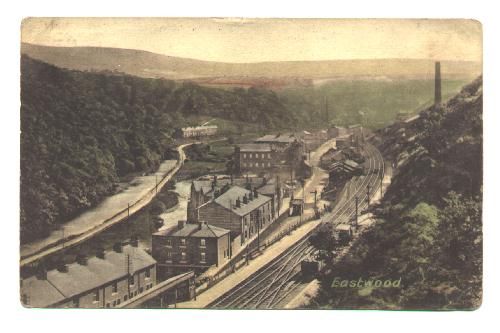
Thanks to Maurice Hartley for this postcard.
Using the postcard, we can identify several sets of dwellings:
- The terrace in the foreground was considered to be a cut above the other buildings and is still standing. To the rear of the terrace was a small paddock accessible through the terrace cellars.
- The next building was three through dwellings with cellar kitchens (you can just make out the gallery to the nearside of the terrace). The rear access to the cellars was by a footpath.
- The next larger terrace had five dwellings on the Halifax Road side called Birch Street and five along the gallery at the back overlooking the river called Woodland View. Birch Street and Woodland View were built by William Cockroft in about 1870. On the corner of Halifax Road Hannah Cockroft ran a corner shop from about 1880 to about 1906.
Several members of the Hill family lived on Birch street. They were active in the social life of Eastwood, being involved in the Chapel, the Good templars and the tennis club. Edna Hill introduced the first Pace Egg play in the area in the 20s, she also was a founder member and secretary of Hebden bridge Little Theatre.
The District Bank rented a house on the road side and a clerk used it as an office one day a week. In about 1920, the council was working on the bed of the River Calder beneath the gallery of Woodland View and a corner of the bedroom collapsed, luckily nobody was hurt. The owners James Cockroft and Betty Hill sued the council, but lost. The terrace was demolished in about 1960.
Next were two or three terraces end on to Halifax road called Ash, (Oak?) and Valley Streets. These went down to the river edge and were owned by Mitchells the coal merchants. Residents talk of Ronnie Henley collecting the rents and the terrace being poorly maintained (the end of Birch street fell into the river and had to be rebuilt).
The site of these three streets is now a patch of grass - probably indicating that they were condemned and pulled down by the council, in the 1960s.
The land beyond up to the chapel was also owned by Mitchells. On this site Mitchells had coke tips and at some time there was a wooden building used by Finney's chicks.
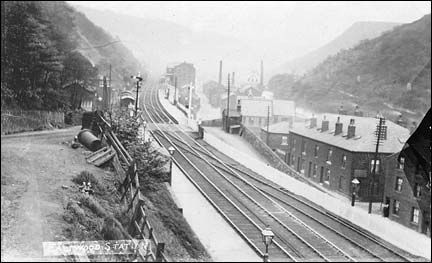
Photo from the Alice Longstaff collection.
The mill in the distance is almost certainly Halsteads, the terraces on the right are Ash, Oak and Valley Street. The shop on the near corner was called Benny Tonks which was a general store selling everything, there was also a sweet shop at the far end.
Benny Tonks shop was opened in about 1880 and was rented from Amos Mitchell. It was run by William Mitchell (known as Billy Pegs) and his wife. They were joined in about 1920 by their niece Edith Ellen. It was Edith who married Benny Tonks from Charlestown at Eastwood chapel in about 1925.



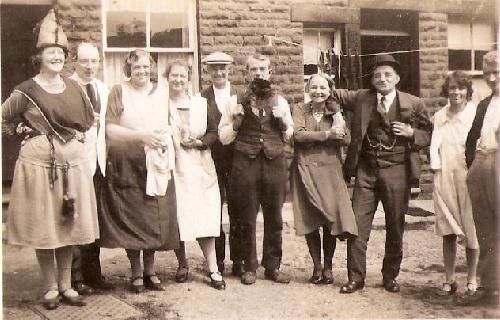
Helen Marshall, Benny Tonks, Edith Tonks, Jim Marshall, Unknown, Mr and Mrs Butterworth, Unknown, Unknown
EASTWOOD STATION
The station was built on the original site of Eastwood Chapel, but little evidence of its existence remains. A large number of cottages were built right down to the site of the old Myrtle Grove Chapel, and the old inn at Bottoms. These two sites were absorbed when the railway was made and the chapel and the new Station House Inn built in their stead, the railway company greatly assisting in the provision of funds. The station in its heyday was a busy place with local and long distant trains stopping. Many people used the station to commute to factories in Rochdale and further afield to Manchester.
The shelter (in the foreground of the photo above) was pulled down in the 1930s. Two sloping cobbled roadways (still in existence) provided access to the station with a porters cabin at the top to unload luggage (the cabin can be seen in the photo above and was later demolished by Jack Shackleton from Higher Eastwood).

One report in the Todmorden Almanac in May 1890 refers to a deserter named Kinchlee from the 68th Durham Foot Regiment jumped from an express train as it passed Eastwood Station and made his escape.

Photo from the Alice Longstaff collection.
The far building is the signal box for the coal sidings with the water pump just visible. The low building was the waiting room and ticket office (run by an Edith Pilling in the 1930s). The large building in the foreground was the station masters house. The number of staff employed at the station indicates how busy the station was.

The names of station masters recorded are:
- 1841 James Brown
- 1842 John Hitchen
- 1849 Henry Hughes
- 1850 W.H.Johnston
- 1854 Andrew Aspden
- 1855 Thomas Bentley
- 1867 G.Tilburn
- 1872 John Ratcliff
- 1891 Mr T Hall
- 1901 Thomas Allott
Some time later the station was run by Charlie Oldroyd. The last station master was George Logan.

The terrace was called Valley Street with Benny Tonk's shop at the end. The carts were part of the Mitchell's coal and haulage business. Photo from the Alice Longstaff collection.
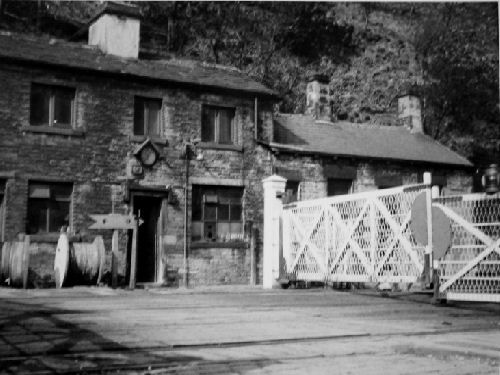
The photo was probably taken not long before the station closed.
Commuting is often thought to be a relatively modern practice, but in the 1920s one of the Crabtree family became a student at Manchester University and travelled in each day in morning dress and a bowler hat!
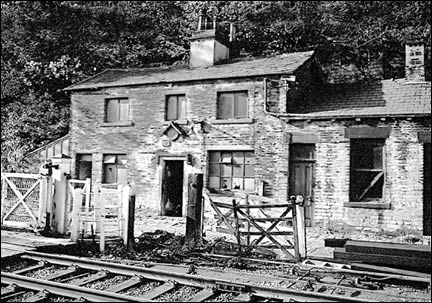
Photo from the Alice Longstaff collection.
EASTWOOD SCHOOL
Eastwood (Day) School was opposite the station (the gate posts can still be seen outside Thornber's). At its peak, the school had about 60 pupils in four classes with two teachers. The building was divided into two sections for Standard 1 and 2 and standard 3 and 4 (infants and juniors).
The Day school was established by the School Board in about 1875. Before then children were taught at a Dame School which was probably in the Sunday School premises of the Chapel. Children were charged one penny a week for lessons at the Dame School, which prevented many families from using the school and made some choose one child to go as that was all they could afford.
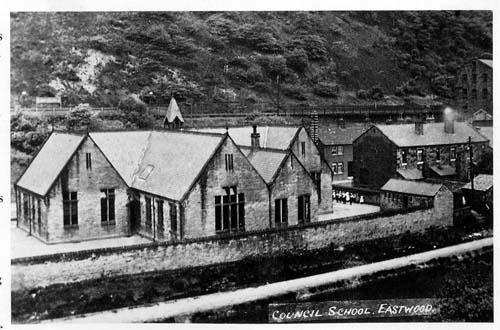
Note the station sign on the left above the school.
The following description of the school was given to us by Mrs Suffolk (nee Cockroft) who attended the school in the 1920s.
"There was a system of pupils who had passed the standard exams to teach the younger children. My mother was a pupil teacher in the 1880s, but failed the qualifying exam and went to Bridge End as an 'ender and mender'- finishing off the ends of cloth and repairing tears".
"Miss Hettie (Greenwood) who was born in about 1890 became an unqualified teacher. When her parents moved to Thornton, Miss Hettie lived at the Station House Hotel during the week. This caused a sensation in the village, as most were strict Good Templars (who were tee total)".
"Children (boys and girls) were taught to knit and sew, but they also learnt to write, read and figure. My mother knew far more about geography than I ever did"!
"If the Board School had not been established, what chance had children of 'bettering' their lot".

We have no details of the date or people in the photo, but it is probably around 1900.

The Todmorden Almanac reports that on 5th and 8th Oct 1891 there were attempted robberies at the Board School, a desk and several drawers were forced but nothing was taken.

Back row (l to r) Franklin Greenwood, (headmaster), Cyril Moss, Alan Priestley, Frank Stanyer, Derek Dawson, ? Houghton, Douglas Halstead, Miss Moss, (class teacher)* Front row (l to r) Irene Gill, Ada Robertshaw, Dorothy Lomas, unknown, Dorothy Woodhead, Lena Barrett, Rita Ashworth, Edith Fielden Thanks to Derek Dawson for this photo *Miss Moss's father owned a sweet shop on Market Street, Hebden Bridge and was well remembered for bringing in chocolate eggs for every child each Easter. Franklin Greenwood and Miss Emily Moss taught in the senior school from 1919 to 1946. Miss Greenwood taught 'the babies' from about 1919.
Some more memories from Mrs. Suffolk.
"In about 1920, there was a very strict master called Mr. (Johnny) Briggs. Woe betide any boy whose clogs were not polished til he could see his face in them. All the girls and boys wore clogs which were supplied by George Henry at the clogging hut by the Post Office".
"There was a well by the girls entrance, safeguarded by iron railings and a padlocked door. It was probably the source of water for the Woodmill area at one time".
Each year three children gained a County Minor scholarship to the grammar school, the rest went to Roomfield School in Todmorden (now pulled down). There seems to be some debate about whether the children that went to the grammar school went because of their ability or because they were the children of influential parents.
Life at the school was eventful being frequently affected by the river bursting its banks, flooding the boiler and providing another day off.
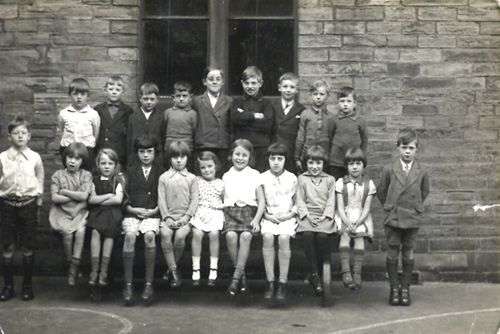
We have no details of the date or people in the photo.
In 1932 the school stopped to watch a strange caravan of caged lions and tigers coming down the main road. Unfortunately the elephant leading the procession dropped a huge pile of dung outside the school with the long suffering wife of the head teacher Mrs Halstead had to clean up. In 1935 the school joined the celebrations for the jubilee of George V and Queen Mary, representing Scotland in the procession to Todmorden park.

Back row boys from left: unknown, unknown, Victor Clark, Albert Martin, Billy Gadsby, Alan Barker, Victor Sutcliffe, Douglas Roberts, Miss Thorp Back row Girls from left: Joan Sutcliffe, Hazel Oldfield, unknown, unknown, Marjorie Christie, Thelma Britton, Elsie Biggins, Gwen Dawson, Doris Greenwood, Edith Fogill, Joan Bowker, Mary Lucas Front row girls from left: Marion Stansfield, Muriel Burn, unknown, Winnie Park, Alice Greenwood, unknown, Vera Gadsby, Kathleen Jennings, Doris Greenwood Front row boys from left: Phillip Sutcliffe, unknown, Eric Dawson, Maurice Stansfield, Angus Barker, unknown, unknown
![Eastwood School group 1933(https://res.cloudinary.com/hzfgq2dal/image/upload/v1638811533/eastwoodschool2_6803119df4.jpg)
Back row standing from left: Miss Emily Moss, Richard Bowker, Eric Dawson, Alan Barker, unknown, Albert Martin, Wilfred Lucas, Leslie Batty, Victor Clark, Unknown Middle row standing from left: Wilfred Ashburner, Winnie Park, Doris Greenwood, Muriel Burn, Dorothy Greenwood, Marjorie Christie, Thelma Britton, Doris Greenwood, Edith Fogill, Joe Fogill, F Greenwood, Headmaster Front row standing from left: Victor Sutcliffe, Unknown, Joan Sutcliffe, Hazel oldfield, Mary Lucas, Joan Rhodes, Billy Gadsby, Walter Riley, ? Snell Front row seated from left: Harry Green, Unknown, ? Marshall
After the school closure
The school closed in the Autumn of 1945. Iit was later demolished with some of the stone being used to build a mill. The mill with north lights was used as a sewing shop owned by a Mr. Greenwood who lived in the terrace next to the mill. It was later used as a foundry called Lowes Castings. Since 1980 it has been used as a sheet metal works, owned by Thornbers who make poultry cages.
OTHER BUILDINGS IN THE LOCALITY
The terrace to the east of the school had Phillip Greenwood's butchers shop and Mrs Smith's sweet shop at the other end. In the 1920s and 30s the butcher shop was owned by a Charlie Lord. Mrs Lord who served in the shop wore a black victorian style dress with no apron.
On the east side of the terrace was a weaving shed called Dick and Annies (or Dick O'Nannys) which sold knitting wool to the public. Next door to that was a warehouse which after the war was full of cocoa beans.
These sites are presently occupied by Murgatroyds motor repair business.
This page was last updated April 2009